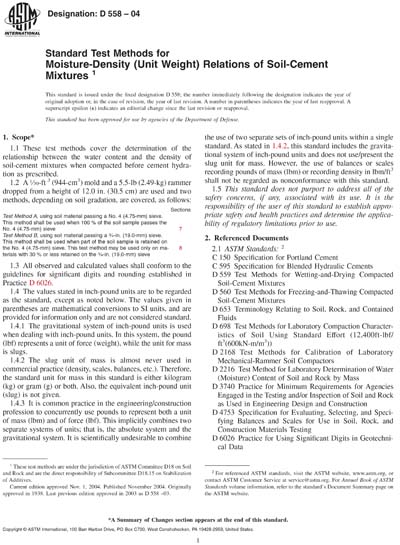Historical
ASTM D558-04
Standard Test Methods for Moisture-Density (Unit Weight) Relations of Soil-Cement Mixtures
1.1 These test methods cover the determination of the relationship between the water content and the density of soil-cement mixtures when compacted before cement hydration as prescribed.
1.2 A 1/30-ft³ (944-cm³) mold and a 5.5-lb (2.49-kg) rammer dropped from a height of 12.0 in. (30.5 cm) are used and two methods, depending on soil gradation, are covered, as follows:
| Sections | Test Method A, using soil material passing a No. 4 (4.75-mm) sieve. |
| This method shall be used when 100 % of the soil sample passes the No. 4 (4.75-mm) sieve | 7 |
| Test Method B, using soil material passing a 3/4-in. (19.0-mm) sieve. | |
| This method shall be used when part of the soil sample is retained on the No. 4 (4.75-mm) sieve. This test method may be used only on materials with 30 % or less retained on the 3/4-in. (19.0-mm) sieve | 8 |
1.3 All observed and calculated values shall conform to the guidelines for significant digits and rounding established in Practice D 6026.
1.4 The values stated in inch-pound units are to be regarded as the standard, except as noted below. The values given in parentheses are mathematical conversions to SI units, and are provided for information only and are not considered standard.
1.4.1 The gravitational system of inch-pound units is used when dealing with inch-pound units. In this system, the pound (lbf) represents a unit of force (weight), while the unit for mass is slugs.
1.4.2 The slug unit of mass is almost never used in commercial practice (density, scales, balances, etc.). Therefore, the standard unit for mass in this standard is either kilogram (kg) or gram (g) or both. Also, the equivalent inch-pound unit (slug) is not given.
1.4.3 It is common practice in the engineering/construction profession to concurrently use pounds to represent both a unit of mass (lbm) and of force (lbf). This implicitly combines two separate systems of units; that is, the absolute system and the gravitational system. It is scientifically undesirable to combine the use of two separate sets of inch-pound units within a single standard. As stated in 1.4.2, this standard includes the gravitational system of inch-pound units and does not use/present the slug unit for mass. However, the use of balances or scales recording pounds of mass (lbm) or recording density in lbm/ft³ shall not be regarded as nonconformance with this standard.
1.5 This standard does not purport to address all of the safety concerns, if any, associated with its use. It is the responsibility of the user of this standard to establish appropriate safety and health practices and determine the applicability of regulatory limitations prior to use.
ASTM International [astm]

